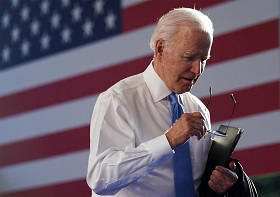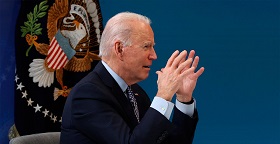The US Treasury has released an overview of its sanctions policy. It outlines key principles for making the restrictive US measures more effective. The revision of the sanctions policy was announced at the beginning of Joe Biden’s presidential term. The new review can be considered one of the results of this work. At the same time, it is difficult to find signs of qualitative changes in the US administration’s approach to sanctions in the document. Rather, it is about upgrading an existing platform.
Notable part of the review concerns possible obstacles to the effective implementation of US sanctions. These include, among other things, the efforts of the opponents of the United States to change the global financial architecture, reducing the share of the dollar in the national settlements of both opponents and some allies of the United States.
The text does propose measures to modernise the sanctions policy. The first one is to build sanctions into the broader context of US foreign policy. Sanctions are not important in and of themselves, but as part of a broader palette of policy instruments. The second measure is to strengthen interdepartmental coordination in the application of sanctions in parallel with increased coordination of US sanctions with the actions of American allies. The third measure is a more accurate calibration of sanctions in order to avoid humanitarian damage, as well as damage to American business. The fourth measure is to improve the enforceability and clarity of the sanctions policy. Here we can talk about both the legal uncertainty of some decrees and laws, and about an adequate understanding of the sanctions programmes on the part of business. Finally, fifth is the improvement and development of the Treasury-based sanctions apparatus, including investments in technology, staff training and infrastructure.
The US Treasury review suggests that no signs of an easing are foreseen for the key targets of US sanctions. At the same time, American business and its many foreign counterparties can benefit from the modernisation of the US sanctions policy. Legal certainty can reduce excess compliance as well as help avoid associated losses.
The US Treasury has released an overview of its sanctions policy. It outlines key principles for making the restrictive US measures more effective. The revision of the sanctions policy was announced at the beginning of Joe Biden’s presidential term. The new review can be considered one of the results of this work. At the same time, it is difficult to find signs of qualitative changes in the US administration’s approach to sanctions in the document. Rather, it is about upgrading an existing platform.
Sanctions are understood as economic and financial restrictions that make it possible to harm the enemies of the United States, prevent or hinder their actions, and send them a clear political signal. The text reproduces the usual “behavioural” understanding of sanctions. They are viewed as a means of influencing the behaviour of foreign players whose actions threaten the security or contradict the national interests of the United States. The review also defines the institutional structure of the sanctions policy. According to the document, it includes the Treasury, the State Department, and the National Security Council. The Treasury plays the role of the leading executor of the sanctions policy, and the State Department and the NSS determine the political direction of their application, despite the fact that the State Department itself is also responsible for the implementation of a number of sanctions programmes. This line also includes the Department of Justice, which uses coercive measures against violators of the US sanctions regime.
Interestingly, the Department of Commerce is not mentioned among the institutions. The review focuses only on a specific segment of the sanctions policy that is implemented by the Treasury. However, it is the Treasury that is currently at the forefront of the application of restrictive measures. A significant part of the executive orders of the President of the United States and sanctions laws imply blocking financial sanctions in the form of an asset freeze and a ban on transactions with individuals and organisations. Decrees and laws assign the application of such measures to the Treasury in cooperation with the Department of State and the Attorney General. Therefore, the institutional link mentioned in the review reflects the spirit and letter of a significant array of US regulations concerning sanctions. The Department of Commerce and its Bureau of Industry and Security are responsible for a different segment of the sanctions policy, which does not diminish its importance. Export controls can cause a lot of trouble for individual countries and companies.
Another notable part of the review concerns possible obstacles to the effective implementation of US sanctions. These include, among other things, the efforts of the opponents of the United States to change the global financial architecture, reducing the share of the dollar in the national settlements of both opponents and some allies of the United States.
Indeed, such major powers as Russia and China have seriously considered the risks of being involved in a global American-centric financial system.
The course towards the sovereignty of national financial systems and settlements with foreign countries is largely justified by the risk of sanctions.
Russia, for example, is vigorously pursuing the development of a National Payment System, as well as a Financial Messaging System. There has been a cautious but consistent policy of reducing the share of the dollar in external settlements. China, which has much greater economic potential, is building systems of “internal and external circulation”. Even the European Union has embarked on an increase in the role of the euro, taking into account the risk of secondary sanctions from “third countries”, which are often understood between the lines as the United States.
Digital currencies and new payment technologies also pose a threat to the effectiveness of sanctions. Moreover, here the players can be both large powers and many other states and non-state structures. It is interesting that digital currencies at a certain stage may present a common challenge to the United States, Russia, China, the EU and a number of other countries. After all, they can be used not only to circumvent sanctions, but also, for example, to finance terrorism or in money laundering. However, the review does not mention such common interests.
The text does propose measures to modernise the sanctions policy. The first one is to build sanctions into the broader context of US foreign policy. Sanctions are not important in and of themselves, but as part of a broader palette of policy instruments. The second measure is to strengthen interdepartmental coordination in the application of sanctions in parallel with increased coordination of US sanctions with the actions of American allies. The third measure is a more accurate calibration of sanctions in order to avoid humanitarian damage, as well as damage to American business. The fourth measure is to improve the enforceability and clarity of the sanctions policy. Here we can talk about both the legal uncertainty of some decrees and laws, and about an adequate understanding of the sanctions programmes on the part of business. Finally, fifth is the improvement and development of the Treasury-based sanctions apparatus, including investments in technology, staff training and infrastructure.
All these measures can hardly be called new. Experts have long recommended the use of sanctions in combination with other instruments, as well as improved inter-agency coordination. The coordination of sanctions with allies has escalated due to a number of unilateral steps taken by the Trump Administration, including withdrawal from the Iranian nuclear deal or sanctions against Nord Stream 2. However, the very importance of such coordination has not been questioned in the past and has even been reflected in American legislation (Iran). The need for a clearer understanding of sanctions policy has also been long overdue. Its relevance is illustrated, among other things, by the large number of unintentional violations of the US sanctions regime by American and foreign businesses. The problem of overcompliance is also relevant, when companies refuse transactions even when they are allowed. The reason is the fear of possible coercive measures by the US authorities. Finally, improving the sanctioning apparatus is also a long-standing topic. In particular, expanding the resources of the Administration in the application of sanctions was recommended by the US Audit Office in a 2019 report.
The US Treasury review suggests that no signs of an easing are foreseen for the key targets of US sanctions. At the same time, American business and its many foreign counterparties can benefit from the modernisation of the US sanctions policy. Legal certainty can reduce excess compliance as well as help avoid associated losses.
First published in the Valdai Discussion Club.






